14 Hidden Secrets in Whistler That Nearly All Visitors Miss
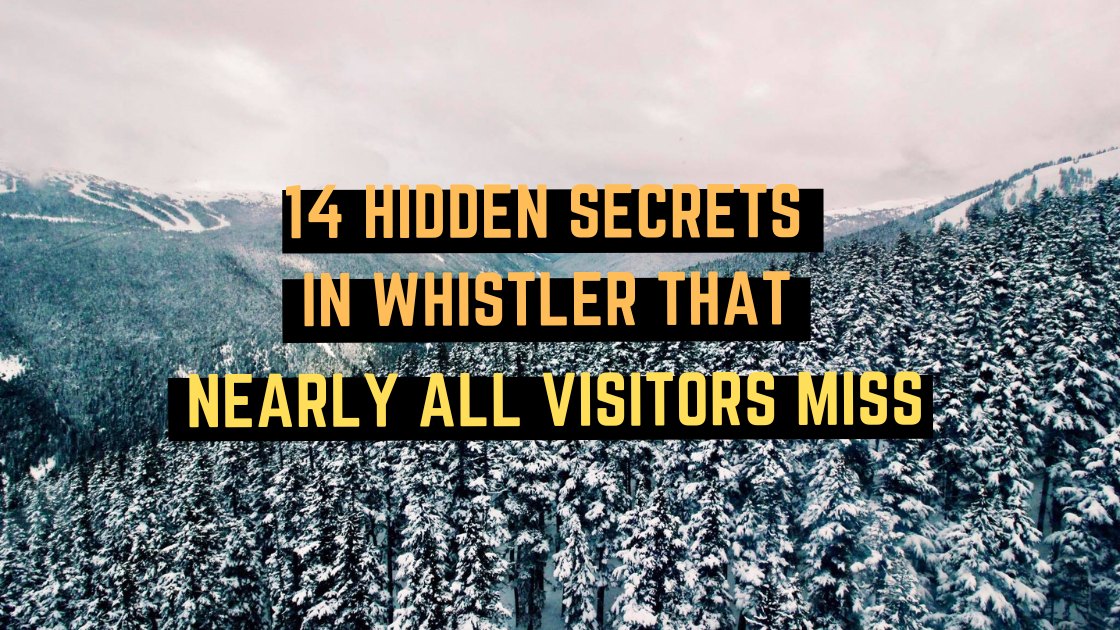
Whistler, BC: Home of the world’s greatest mountain bike competition and the largest ski resort in North America. There are world class adventures by the hundreds here. But what about the many places you won’t see in the glossy magazines and Instagram feeds? If you venture off the beaten track in Whistler, you’ll find a different world entirely.
From discovering hidden gems in the coastal rainforest, to sampling delicious local produce, to throwing axes with the locals, you’ll be surprised by how much you’ll find. If you’re planning a trip to Whistler, make time to try at least one of these Whistler secrets.
1. Paddleboard a Lake
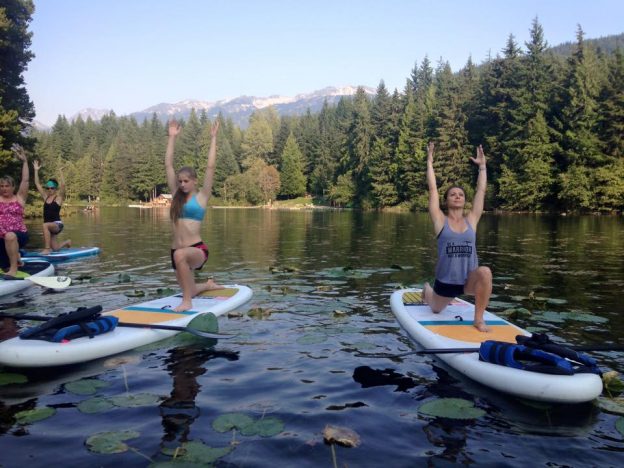
You haven’t been to Whistler if you didn’t do yoga on a paddleboard.
Season: Summer
Why it’s awesome: Whistler’s lakes are the go-to spots for locals to hang out on a sunny summer’s day. They offer stunning views, perfect picnic spots, and respite from the sometimes sweltering heat. But don’t stick to the beaches—grab a paddleboard and go explore.
Go it alone: Alta Lake is the best spot to rent a paddleboard in Whistler, and the vast expanse of clear blue water promises a full day of adventure. Both Lakeside Park and Wayside Park have hourly and daily paddleboard rentals, and their helpful staff will teach you the basics and provide safety equipment too.
Grab a guide: If you want a little more guidance, consider booking a paddleboard tour. As well as teaching you to paddle like a pro, your guide will clue you in on the local history of Whistler and help you spy some of the resident wildlife.
Local’s tip: If you’re feeling confident, it’s time to venture away from the still waters of Alta Lake and take on the River of Golden Dreams. Navigate your way through the fast-flowing waters and take in the views as you wind your way to Green Lake. This is a full-day adventure, so come prepared and check conditions to ensure the water level isn’t either too low or too high.
2. Sample Craft Beers in Function Junction
Season: Year-round
Why it’s awesome: One of the best additions to Whistler’s apres scene over the last few years has been the birth of a booming craft beer scene. And Function Junction – the up-and-coming industrial neighbourhood at the southend of Whistler – is one of the best places to sample some of Whistler’s finest craft brews. Constantly growing and innovating, the local breweries have a dedicated fan base in Whistler and beyond.
What to expect: There are two great local breweries in Function Junction: Whistler Brewing and Coast Mountain Brewing. Both offer an ever-changing rotating cast of beers that has sparked many a life-long love affair with craft brewing.
How to get there: Function Junction is 15 minutes south of Whistler Village and can be reached by public transit or taxi. If you’ve got a bike, try out the Valley Trail bike trail that runs throughout Whistler.
Locals’ tip: Both breweries are open from around 12pm every day, and close around 8pm (check beforehand, as they sometimes close early on weeknights). The busiest time is around 5pm, when locals leave their offices (yes, there are office jobs in Whistler) and kick back for a few local brews.
3. Try Your Hand at Forged Axe Throwing

We are so clearly in love with this sport.
Season: Year-round
Why it’s awesome: Throwing axes is as quintessentially Canadian as you can get. But visitors have only recently had the chance to take part in this great Canadian tradition. You don’t need to know how to throw, as axe throw
ing hosts will teach you all you need to know. Just bring your enthusiasm, a few friends, and a little competitive spirit.
What to expect: The concept is pretty simple: You throw axes at a target, and it feels great when they thunk into the wood. Then add a charming axe-throwing host and some friendly competition and you’ve got yourselves the ultimate Canadian day out.
How to get there: Forged Axe Throwing is in Function Junction, 15 minutes south of Whistler Village (and delightfully close to the local breweries for a post-game beverage).
How to book: Pop over to the bookings page to reserve a spot with your friends. Forged also hosts private axe-throwing parties (perfect for bachelorettes, corporate trips, and wedding parties), or you might catch our trailer at events and festivals around Whistler.
Locals’ tip: Everyone is welcome, from kids ages 10+. You can even bring your pooch along to watch. Now featuring a selection of beers and wines, axe throwing can be a great way to spend an evening with friends.
4. Take the Train Wreck Hike
Season: Spring – Fall
Why you should go: The Train Wreck is a quirky part of Whistler history, wrapped up in an accessible hike full of great views. The “Train Wreck” refers to the scattered carriages of a freight train that flew off the tracks many years ago. Since then, the rusting containers have been taken over by local mountain bikers and graffiti artists, who have turned the wreckage into a bike park and living piece of artwork.
How to find it: Start from the car park by Forecast Coffee (just down the road from Forged) in Function Junction. You’ll see the trail signposted into the forest. From there, look for coloured blazes on trees and rocks, which will lead you through dense forest, past crashing waterfalls, and finally to the train wreck itself.
Local’s tip: Tie together the Train Wreck, a trip to Forged Axe Throwing, and a visit to Whistler’s local breweries for a full day of exploring the little-known delights of Function Junction.
5. Shred Secret Mountain Stashes of Powder
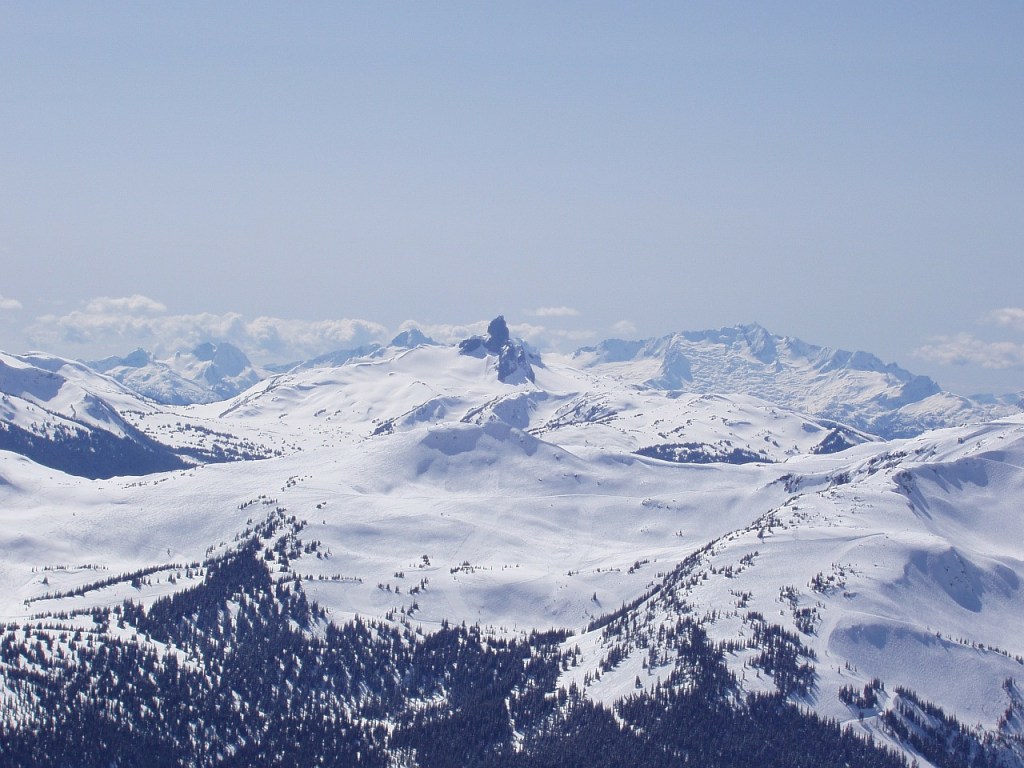
With so much terrain, you’ll never run out of pow.
Season: Winter
What to expect: It’s hard to pick just one favourite spot in Whistler’s 8000+ acres of terrain. So here are a few little gems that are worth seeking out, whatever your ability.
Intermediate: To get a taste of that west coast pow, without overstepping your limits, do some quick laps under Whistler T-bar. The pitch is steep enough to be fun but not scary, and you can ski several different lines down the wide, open bowl.
Advanced: Even late in the day, some of the best snow can be found in Blackcomb’s Secret Bowl. Head up Seventh Heaven chairlift, then traverse left along the cat track. Straight ahead is the hair-raising Saudan Couloir, but a little lower you can choose from a few more straightforward descents: Pakololo, Secret Chute, and Cougar Chutes.
Expert: Not for the fainthearted, Spanky’s ladder gives access to four alpine bowls: Ruby, Garnet, Diamond, and Sapphire. They all offer steep faces, narrow chutes, and drops galore. For experienced powder enthusiasts, these are laps you’ll remember for the rest of your life.
Local’s tip: Before you head out, ask for some tips from the friendly locals you’ve met. Whistler Blackcomb is big and can be unforgiving. It’s crucial that you choose runs that are appropriate for your skill level to avoid dangers like tree wells or cliff drops. Don’t ruin your holiday by getting into an avoidable, sketchy situation.
6. Try the Locals’ Favourite Breakfast
Season: Year-round
Why it’s awesome: Everyone in Whistler knows that breakfast is the most important meal of the day. You simply can’t adventure without it. With that in mind, there are almost endless excellent breakfast options available.
But, if we had to choose, we would have to say our favourite is the Southside Diner. This old-school diner just oozes with Canadian spirit and evokes memories of road trips from years gone by. Offering their own twists on Canadian classics, Southside has something for everyone.
How to get there: You can find Southside Diner in Creekside, about 10 minutes south of the village on Highway 99. Get there on public transit or by grabbing a taxi from the taxi loop.
Local’s tip: Get the Breakfast Poutine (poutine is always a great idea) or the Big Ass Pancakes. They’re seriously big. And delicious. Top it off with one of their signature Caesar’s and you have yourself a very good start to the day.
7. Learn to Fly Fish
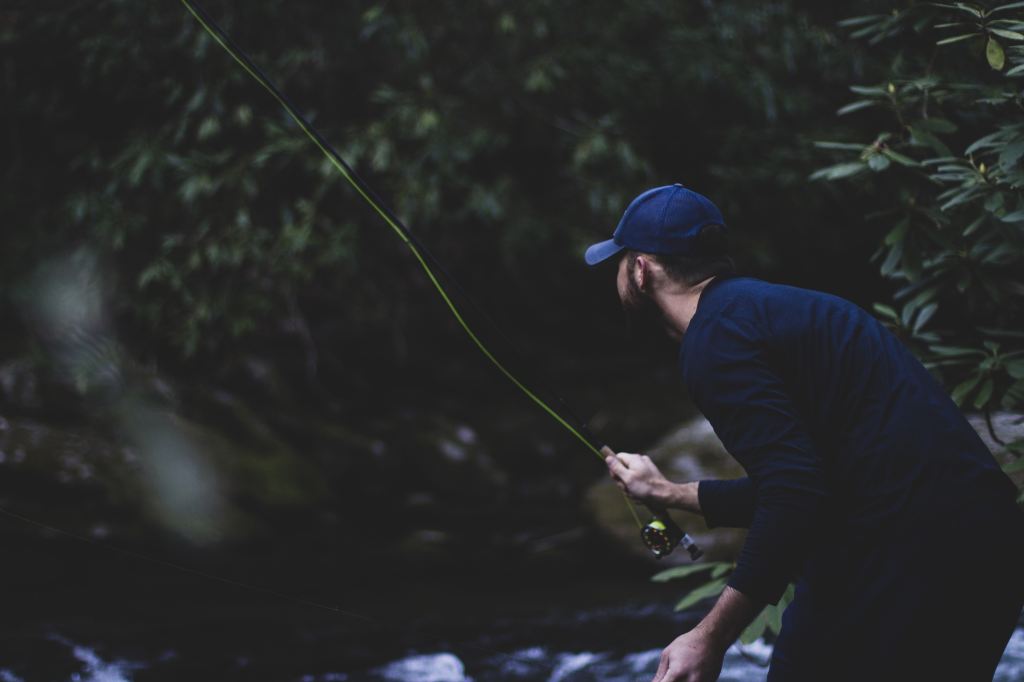
Hit one of these local spots on your next trip to the Sea to Sky
Season: Summer (though in winter you can try ice fishing instead)
Why it’s awesome: With so many adrenaline-pumping activities to try out in Whistler, the more serene pursuit of fishing is often overlooked. And that’s a huge shame, because the fly fishing here is world class. With boundless alpine lakes, an almost pristine environment, and diverse species of fish, Whistler is a fly-fisher’s paradise.
Go it alone: If you want an introduction to fly fishing in Whistler, start at Lost Lake. There you’ll find a healthy population of rainbow trout and custom-made floating docks to fish from. Plus, Lost Lake is one of the warmest lakes in Whistler, so you can always take a dip between casts.
Local’s tip: For the best Whistler fly fishing experience, we’d recommend hiring a guide. There are several fishing guides in Whistler and all boast experienced, local staff who know the area like the backs of their hands. Some of the best include Whistler Fishing Guides, Pemberton Fish Finder, and Valley Fishing, offering full-day or half-day trips and tailoring the experience to the season, conditions, and your interests.
8. Discover Logger’s Lake
Season: Year-round
What to expect: Logger’s Lake is the definition of a hidden gem. Although it’s actually quite accessible from Whistler Village, you won’t find the crowds here. This great little lake is hidden in the forest high above Cheakamus. In the summer, it’s small size means it warms up quickly, making it the perfect spot for a long day lazing in a floatie.
Why it’s awesome: Logger’s Lake is nestled in an unlikely spot, totally surrounded by forest and in the crater of an ancient volcano. From the lake you can explore a huge network of hiking or mountain biking trails only 20 minutes from the bustling heart of Whistler.
How to get there: Logger’s Lake is accessible via the Cheakamus Forest Service Road. Most cars can make it up, although it isn’t paved, so a 4×4 is recommended. You can park just a short walk away. In winter, the road is not ploughed so you will need chains and to check the latest snow report before going.
Locals’ tip: Whenever you head out in the backcountry (especially in winter), make sure you have the right gear, knowledge, and fitness. The wilderness is close by in Whistler, and it pays to be prepared.
9. Visit the Ice Walls and Caves
Season: Ice Walls in Summer, Ice Caves in Winter
What to expect: During the summer, Whistler Blackcomb opens for a brief sightseeing period. Unlike the valley, there will still be snow in the upper alpine, allowing you and your friends to go for a hike between towering ice walls. In the winter, there are incredible ice caves you can explore on Blackcomb. Large caverns with bright, icy-blue walls, the ice caves are pretty spectacular.
How to get there: In both cases, you’ll have to take the gondola up the mountain. In the summer, you can simply follow the marked hiking trails and will arrive in the ice walls quite quickly. In winter, the ice caves are off to the right on the Blackcomb Glacier Blue Run, accessible from the top of the Showcase T-Bar on Blackcomb Mountain.
Local’s Tip: Both locations can get busy, so if you’d like picturesque photos on your own it’s best to go early.
10. Explore Callaghan Lake
Season: Summer
What to expect: One of the best lakes in Whistler that you can access by car, Callaghan Lake is a picturesque lake and campground in the Callaghan Valley. Be forewarned though, the Forest Service Road to Callaghan can be a bit extreme—think potholes and water bars—but once you arrive it’s an incredibly peaceful and beautiful lake for a camping trip or even a day trip.
How to get there: From Highway 99, you’ll want to take the turn off towards Callaghan Lake Provincial Park. It’s about 14 kilometres south of Whistler. Around 9.5 kilometres up the Callaghan Valley road there will be a turnoff for the lake, and it is a bumpy 8.5 kilometres further.
Local’s tip: If you’re super keen to adventure, there is a secondary lake on the other side of Callaghan Lake that you can access by boat and a short hike. Additionally, there are cool little side adventures on your way to the lake, such as a quick visit to Alexander Falls along the main road.
11. Discover Parkhurst Ghost Village
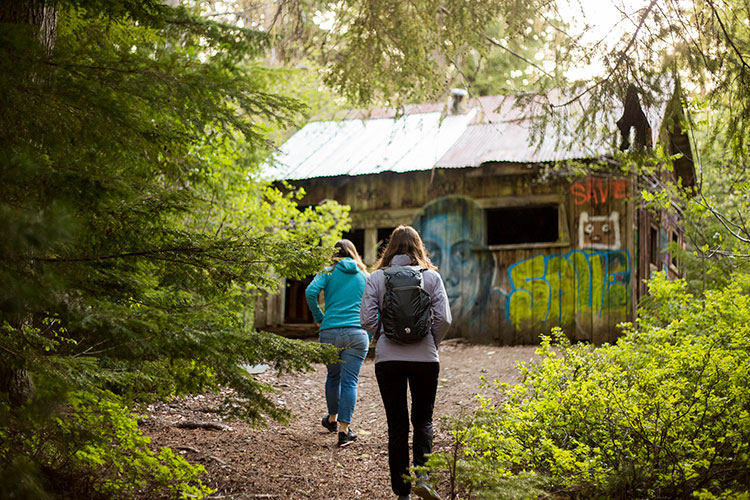
If you are tired of the crowded hiking trails, try checking out Whistler’s hidden ghost town.
Season: Best explored between April and October
What to expect: A former logging settlement next to Green Lake in Whistler, Parkhurst Ghost Village is a blast from the past, featuring abandoned cars, buildings, and mining equipment being slowly reclaimed by the forest. If you’re looking for a local hike that is a step away from the new Whistler and includes a cool bit of the town’s history, Parkhurst is a great bet.
How to get there: Take a short drive north of Whistler to the Wedgemount Lake hiking area and park underneath the power lines. From here, you’ll follow the Green Lake Loop until Jeff’s Trail on your left. Continue until you reach the road and take the left onto Parkhurst Main trail until you arrive at the ghost town.
Local’s tip: The hike is rated as moderate, and the entire trip will likely take you a few hours so it is best to take some water and snacks.
12. Visit Family-Friendly Whistler Olympic Park
Season: Year round
What to expect: Located in the Madeley Basin of the Callaghan Provincial Park, Whistler Olympic Park is home to a variety of outdoor activities. From cross-country skiing, snowshoeing, and even a chance to try the Olympic bobsleigh track to some of Whistler’s best trails in the summer, there are a host of family-friendly outdoor activities available all year round.
How to get there: The Callaghan Provincial Park turnoff is located about 14 kilometres south of Whistler. Luckily, it is not on a difficult road so you will be able to take your own vehicle or go by taxi.
Local’s Tip: If you’re looking to sign up for a guided activity, it’s best to plan ahead and book early to make sure everyone in your party will have a spot.
13. Enjoy the Happiest Hour at Joe Fortes
Season: Year round
What to expect: A new local’s favourite, Joe Fortes’ Happy Hour is a surprisingly great deal. From 3 – 5 pm daily, try out fan favourites like fresh seafood towers, steamed mussels, and the famous lobster and shrimp rolls for friendly Happy Hour prices. To make it even better, the drink specials are some of the best in town. Enjoy a beer for $5, choose between a selection of cocktails for $6-$8, or indulge in delicious wines by Blasted Church for $1 per ounce and join the party.
Local’s Tip: Happy Hour is only hosted on the lounge side of the Joe Fortes restaurant and can fill up quickly, so if you want to guarantee yourselves a seat, aim to get there closer to 3.
14. Try Horseback Riding with Squamish River Horse Adventures
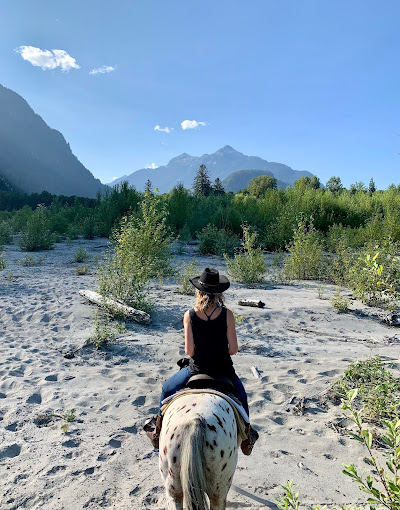
Capture surreal natural moments by horseback Squamish River Valley.
Season: Primarily Spring to Fall
What to Expect: Founded and run by long-time locals, explore some of the best trails Whistler and Squamish have to offer by touring the beautiful Squamish Valley by horseback. Offering one- and two-hour tours for the big kids, and pony rides for the little ones, embrace your inner cowboy or cowgirl with your friends and discover parts of the Sea to Sky that few get to see. From incredible mountain views, to river crossings, and winding trails through old-growth forest, your tour with Squamish River Horse Adventures is sure to be an experience you won’t forget.
How to get there: Located in the Upper Squamish Valley, take the turn opposite Alice Lake Provincial Park towards Squamish Valley road. After passing Fergie’s Restaurant, another great stop, you’ll take the fork towards the Upper Squamish Valley and find the ranch at the end of the main road after 20 minutes or so.
Local’s Tip: Email ahead of time to secure your booking. If your group happens to be more than six people, you may need to book further in advance and bring snacks! Once you discover the beauty of the valley, you won’t be in a rush to get back.
Why It’s Worth Getting off the Beaten Track in Whistler
There’s so much to do in Whistler that you can easily fill a whole trip with world-famous hot spots. But take a step off the beaten track and you’ll be rewarded. There are magnificent views, intriguing stories, and one-of-a-kind adventures around every corner. And if you ask around, we locals are more than happy to share a few more Whistler secrets that will make your vacation even more memorable.
